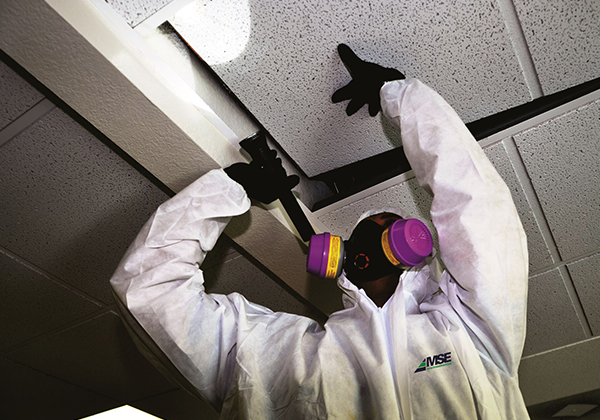The Total Process of Accredited Asbestos Checking to Ensure Building Compliance
In the realm of residential or commercial property administration and compliance, the procedure of certified asbestos testing stands as a vital part to ensure the safety and wellness of passengers. From the preliminary analysis to the last analysis of outcomes, each phase plays a vital role in determining the presence of asbestos within a home.
Accredited Asbestos Screening: Preliminary Evaluation
In performing the first analysis for approved asbestos screening, a precise exam of the residential property's products is critical to properly recognize possible asbestos-containing products. This vital action includes visually inspecting all areas of the building, including ceilings, wall surfaces, flooring, insulation, and various other building materials that may nurture asbestos. Special focus is provided to materials that are susceptible to harm or disturbance, as these scenarios can release harmful asbestos fibers right into the air. Furthermore, sampling of suspected products might be required to confirm the visibility of asbestos with laboratory evaluation.
Certified asbestos assessors adhere to stringent methods set by governing bodies to make sure the precision and integrity of the testing process. By thoroughly recording searchings for and making use of advanced screening methods, assessors can supply property proprietors with a comprehensive report describing the presence of asbestos, if any type of, and the advised steps for mitigation or elimination. This first evaluation sets the foundation for subsequent activities to attend to asbestos concerns and make sure the safety and conformity of the building.
Sample Collection Procedures for Asbestos Evaluating
Effective sample collection procedures are crucial in guaranteeing precise asbestos screening results and compliance with governing standards. When collecting samples for asbestos testing, it is important to comply with stringent methods to decrease the threat of contamination and make certain the reliability of the outcomes.
To start with, it is important to identify the suspected asbestos-containing materials (ACMs) and prioritize tasting locations based on variables such as the material's problem, access, and possibility for disruption. Asbestos Testing. Examples ought to be gathered from various locations within the residential or commercial property to offer an extensive assessment of asbestos presence
Throughout example collection, licensed experts ought to wear appropriate individual safety devices (PPE) to protect against asbestos direct exposure. They need to utilize clean devices, such as disposable gloves and plastic bed linen, to stop cross-contamination in between samples. Examples must be thoroughly collected using a specified strategy, such as damp wiping or coring, and safely sealed in impermeable containers to protect their integrity throughout transport to the research laboratory for analysis.
Lab Evaluation Refine for Asbestos Samples
Upon conclusion of the example collection process, the asbestos samples are diligently transferred to approved laboratories for careful evaluation. The first step in the lab evaluation process is sample prep work, where the accumulated samples are thoroughly refined to remove the asbestos fibers.

When the evaluation is complete, an in-depth record is created, laying out find out here now the searchings for and confirming whether asbestos exists, the kind of asbestos fibers determined, and the concentration degrees. This details is critical for homeowner to take the needed steps to make sure compliance with asbestos guidelines and safeguard the health and wellness of residents.

Coverage and Analysis of Asbestos Test Outcomes
Certified asbestos testing labs give detailed reports that offer important insights right into the existence, kind, and concentration degrees of asbestos fibers discovered in samples collected from residential or commercial properties. These records are necessary for home proprietors and supervisors to recognize the threat posed by asbestos and make informed choices concerning its monitoring or removal. The reports generally include information on the approaches used for testing, the locations where examples were taken, the type of asbestos recognized (such as chrysotile, amosite, or crocidolite), and the concentration levels of asbestos fibers detected.
Analyzing these outcomes calls for proficiency to assess the possible wellness dangers connected with asbestos direct exposure, determine the appropriate strategy, and ensure regulative compliance (Asbestos Testing). Relying on the findings, referrals might vary from continued monitoring and maintenance to encapsulation or complete asbestos abatement. Homeowner need to carefully review these records and seek advice from asbestos specialists to develop a detailed prepare for resolving any type of asbestos problems recognized
Guaranteeing Residential Property Conformity With Asbestos Regulations
To preserve adherence with asbestos policies, property owners should carefully execute measures to ensure compliance with relevant regulations and guidelines. This consists of conducting routine asbestos inspections by recognized specialists to identify any kind of presence of asbestos-containing materials within the property. When asbestos is recognized, residential or commercial property proprietors must comply with asbestos monitoring intends that overview appropriate control, elimination, or encapsulation procedures to avoid direct exposure and spread browse around these guys of asbestos fibers. Conformity also includes maintaining thorough documents of asbestos testing, maintenance, and removal activities for assessment objectives.
Home owners ought to offer asbestos awareness training to employees and occupants to minimize the risk of asbestos direct exposure and make certain correct handling of products that may include asbestos. Additionally, it is essential to stay educated concerning any type of updates or modifications in asbestos policies to adjust administration techniques accordingly. By proactively attending to asbestos conformity requirements, residential property proprietors can create a risk-free setting for occupants and reduce potential lawful and health and wellness risks connected with asbestos direct exposure.
Conclusion
To conclude, approved asbestos testing is an important process for guaranteeing building compliance with laws. The preliminary analysis, example collection procedures, lab evaluation, and analysis of results are very important steps in this procedure. By following these treatments, residential property owners can recognize and deal with any kind of asbestos risks existing, safeguarding the wellness and security of occupants and preserving conformity with regulatory needs.